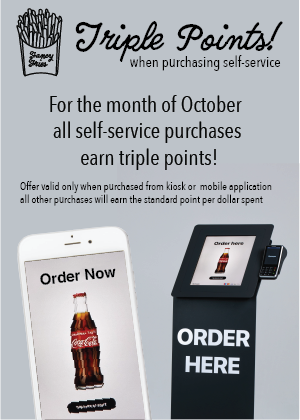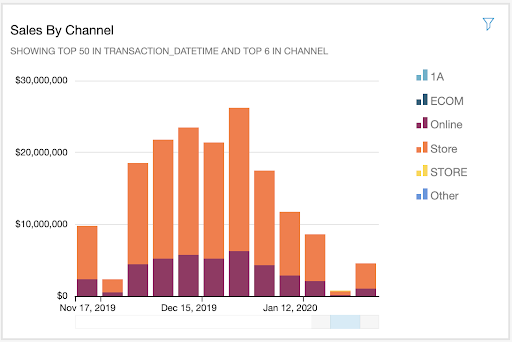Award triple points for self-service orders

Do you want fries with that? Don't even ask. Gone are the days of standing in lines waiting to order food. Today's consumers prefer to skip the line, favoring instead self-service ordering technologies like mobile apps and in-store kiosks that provide a streamlined, no-touch ordering process. Self-service ordering technologies are now a must-have for quick service restaurants (QSRs).
For QSRs, integrating self-service ordering technologies into their loyalty program enables them to provide members with an elevated loyalty experience. Program information is available at their fingertips. Members can check current offers, point status or available rewards with just a few clicks in the mobile app or kiosk. For the loyalty program sponsor, mobile apps and kiosks collect enhanced transaction data that you can use to improve your members' experience as you gain insight into their ordering habits. You can leverage these insights to send personalized offers that build a real connection with your brand.
Strategy
Award triple points for purchases made on a mobile app or at an in-store kiosk during the month of October.
Here’s the scenario: Fancy Fries, a purveyor of upscale casual cuisine, has made a significant investment in their mobile app and in-store kiosks. Fancy Fries wants to provide their patrons with the ease of self-service ordering, while also collecting enhanced data about their shopping habits. To encourage patrons to place self-service orders, Fancy Fries runs a promotion that rewards its loyalty members for using its mobile app or in-store kiosks. For the month of October, mobile app and kiosk orders earn triple points. Let’s look at how this is done in the SessionM platform.
SessionM solution
The SessionM loyalty platform enables you to forge stronger, more loyal and more profitable relationships with your members. The platform is built on a suite of modules - including customer data management, loyalty management, campaign management, and reporting and analysis - that provide the functionality required to build compelling member loyalty programs.
Key modules
The strategy described in this article uses the following modules:

Loyalty Programs
- Point banking
- Rewards for high value behaviors, advocacy and spend
- Status and tiering rules plus outcomes
- Benefits management with frictionless redemption
- Extensive tracking on point liabilities

Campaign
Orchestration
- Manage scheduled and behaviorally triggered campaigns across email, push, SMS, digital channels
- Real-time interaction management
- Rules-based promotions
- Centralized and actionable campaign analytics
See SessionM Features for a full discussion of SessionM platform features and functions.
Implementation workflow
The following procedure describes the workflow for implementing the loyalty program described in this article. The procedure captures the workflow at a high-level, providing you with a sense of the scope involved in implementing this program in the SessionM platform.

Take note
As you follow this workflow, take note of the following:
-
This strategy uses either a mobile app or an in-store kiosk as the channel type (where the purchase is placed). You can define any number of channels within the SessionM platform. Consult with your SessionM delivery team about the channels that you want to be available to your members. During system implementation, the delivery team can make the configuration changes to support your list of channel types.
-
As the sponsor of a loyalty program, there are incentives that you want to make a permanent feature of your program and there are incentives that you want available only for the duration of a promotion. Take this strategy as an example. All purchases, no matter how the member places the order, earn 1 point for every dollar spent. This purchase rule is belongs to a tier, making it a permanent feature of the loyalty program.
The rule granting triple points for self-service orders is defined in a promotional campaign with a defined timeframe. As a result, this purchase rule is only in effect while the campaign is active. During October, self-service orders earn the 3x reward in October. Come November, self-service orders revert to earning a single point for every dollar spent.
Step 1. Existing loyalty program in place
Assume that Fancy Fries has a loyalty program with a single tier in place. A purchase rule embedded in this tier awards 1 point for each dollar spent, regardless of how the order is placed.
Step 2. Campaigns module: Define promotional campaign based on purchase award
Define a promotional campaign that includes a purchase rule that awards triple points for orders on the mobile app and in-store kiosks for the month of October.
-
Select the Campaigns module and create a promotional campaign.
-
Set the runtime to begin on the first day of October and end on the last.
-
Use the default targeting of all loyalty program members.
-
Define the behavior for the campaign.
-
Define a purchase rule that applies to the purchase of any item. Set a restriction where "Qualifying Channel equals mobile_app or kiosk".
-
Set the outcome to 2 points for every dollar spent. (Note that this purchase rules works in conjunction with the purchase rule defined in the tier that awards 1 point for every dollar spent. Combined the rules award 3 points for every dollar spent.)
-
-
Launch the campaign. For the month of October, SessionM "listens" for self-service orders and awards the bonus points when earned.
Step 3. Campaigns module: Define messaging campaign that informs members about promotion
Define a messaging campaign that informs members of the triple point award for orders made using the mobile app or in-store kiosk in October.
-
Select the Campaigns module and create a messaging campaign.
-
Set its runtime to encapsulate the message send time. That is, set the start date/time before the time that the message is sent (for example, the campaign start time is 10/01/2023 12:00 am). Similarly, set the end date/time after the time that the message is sent (for example, 10/01/2023 11:59pm).
-
Use the default targeting of all loyalty program members.
-
Define the messaging for the campaign. Set up an external message with a scheduled delivery method. Set the delivery date/time to "10am on 10/01/23". Select a message provider and template for the email message. This links the SessionM message to an email template within an external email service provider.
-
Launch the campaign. An email announcing the 3x points promotion for self-service orders is sent to all loyalty program members at the specified time.
Analysis
Successful loyalty programs adapt and evolve to meet the needs of their members. It’s crucial to evaluate your loyalty program to determine where it is performing well and where it needs to improve. Built on a series of intuitive dashboards, the SessionM Insights reporting & analysis tool enables you to understand loyalty program performance by measuring key performance indicators such as customer spend and customer frequency.
This strategy promotes self-service orders by rewarding triple points to purchases made using the mobile app or in-store kiosk. Using Insights, compare the "sales by channel" before, during and after the promotion to determine its effect on consumer ordering behavior.

For detailed information on SessionM Insight features and functionality, see About Insights in the SessionM Help Center.

Key takeaways
Provide multiple ordering channels
As the sponsor of a loyalty program, strive to make your loyalty program a natural extension of your members' shopping experience. The transition from shopping to loyalty activities should be transparent. The strategy discussed in this article describes how to incorporate self-service ordering into your loyalty program. Mobile apps and self-service kiosks provide an excellent platform for seamlessly blending your loyalty program in your members' shopping experience.
Make rules permanent program features or limit them to campaigns
Purchase and event rules can be a permanent feature of a loyalty program (defined as part of a tier), or they can be limited to the duration of a specific promotion (defined as part of campaign). This strategy demonstrates both tier-based and campaign-based purchase rules. Use this flexibility to tailor your loyalty program to best serve your members and to achieve your goals.